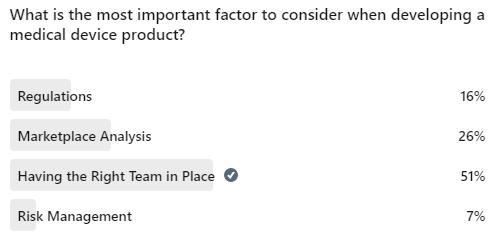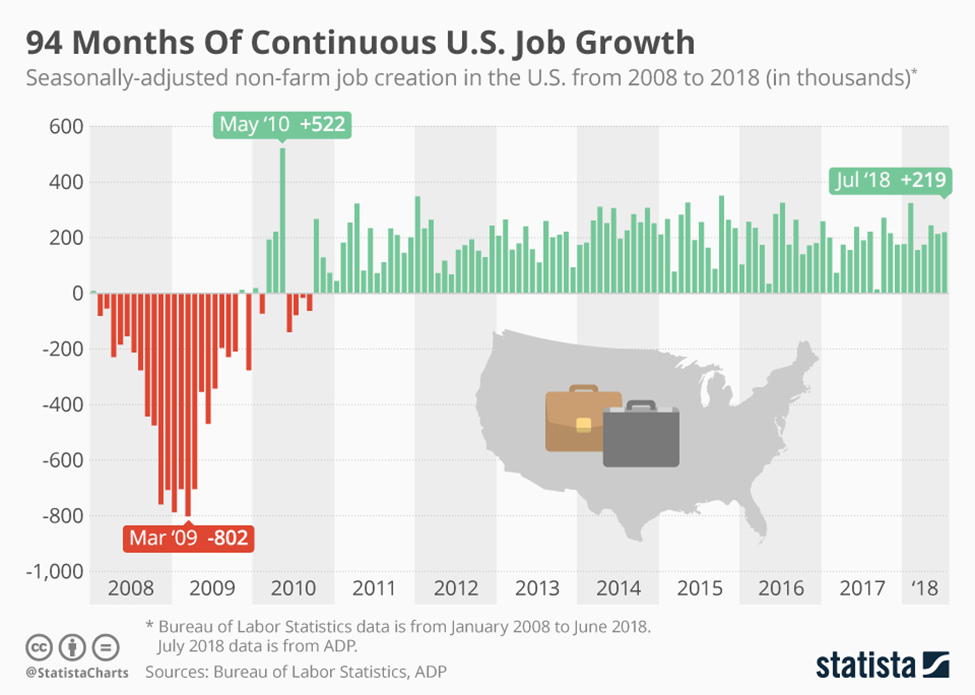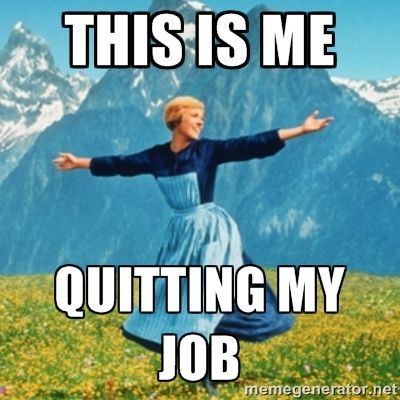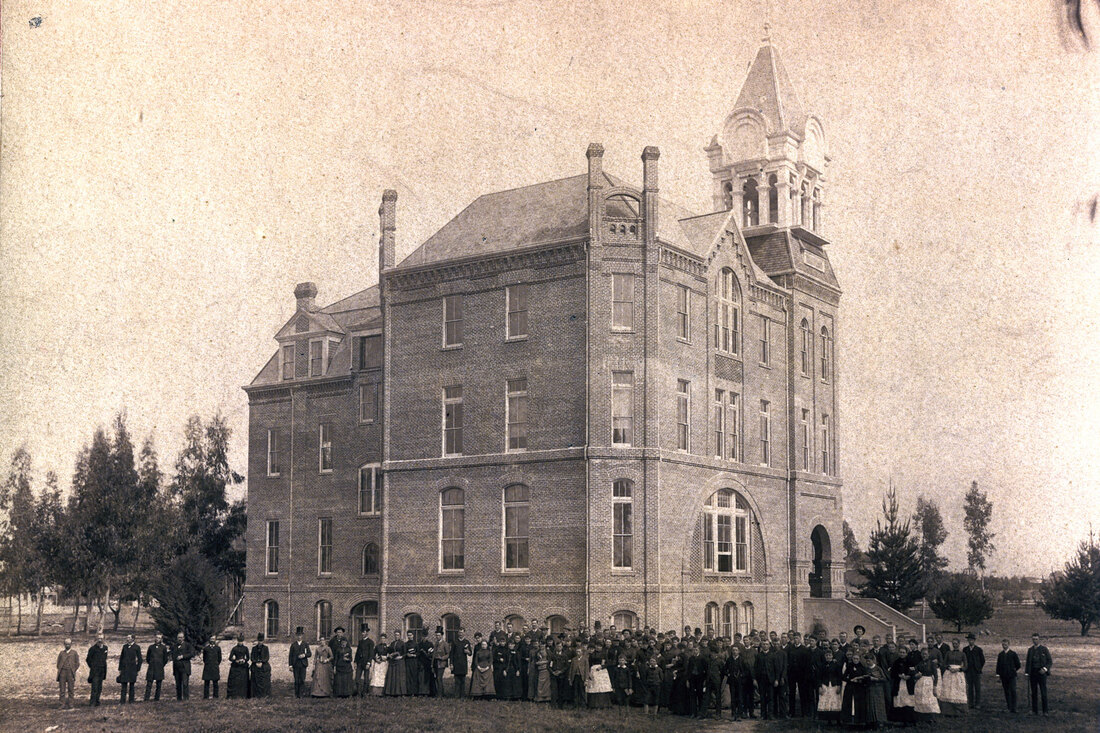|
Recently our company published a poll online offering up the following question for the medical device community: “What is the most important factor to consider when developing a medical device product?” At the close of the poll dozens of people had cast their votes for what they believed to be the factors affecting product development the most. The poll options included:
If you have been in industry for any length of time you know there are dozens of factors which can and often have a direct impact on the product development process. While there are dozens to consider, such as PRS (Product Requirement Specification), planning, user experience, DFM, etc. what we know to be true is each of these factors carry varying weights of impact. They are not all equal in measure or influence. As our poll launched and picked up steam one of the four factors listed as an option began to take a commanding lead. The respondents, who are largely made up of medical device professionals and executives, had identified a common factor which stood above the rest in its ability to impact positively or negatively the product development process. What was this most important factor? Would you have guessed ‘Having the Right Team in Place’ is the number one factor which determines success when developing a medical device product? ‘Having the Right Team in Place’ was identified by 51% of the respondents as being the most important factor which directly contributes to the success of medical device product development. The other options broke down as follows: Simply put – having the right team in place covers all of the other areas that potentially could produce challenges during the product development cycle. Whereas the inverse is certainly all too true. When we have the wrong team in place, or teammates lacking the capabilities to facilitate their job as needed by the company, inevitably problems go arise which hold back otherwise good opportunities and technology offerings. Jim Collins, celebrated author (books like ‘Good to Great’ & ‘Built to Last’) and business management guru, is quoted as saying “Leaders of great companies start by getting the right people on the bus, the wrong people off the bus, and the right people in the right seats.” What this means is it’s more about the people than it is the technology or problem you’re solving. This is an important lesson, especially for first time entrepreneurs and startup executives. You can have the best product idea in the world, one that is in high demand, but if you don’t have the right team in place you’ll most likely spin your wheels while blowing out copious amounts of money in the process. We’ve also seen this reality in person dozens of times. As a medical device consulting firm we work with a lot of companies, both start up and conglomerate alike. One of the consistent characteristics we see within the companies which are able to drive success, often times repeated success, is their management team is comprised of experts in their particular field who know how to both lead and operate in the weeds. They both strategic and tactical, able to plan for the long term while addressing todays shorter term needs. As a result, they know how the job is done and therefore can either lead or delegate those tasks helping to guide their department or team to successful completion. When you have the right people on the team (your bus) you will then find opportunities (the medical problem you’ll solve) to move forward with. Following this process you’ll also have a far better chance of facilitating that opportunity through the development process and into commercialization, or acquisition.
0 Comments
You read that right. For the first time in decades there are more jobs available than the actual number of people that are on unemployment. As of July 2018 there are 6.3 million people in the US on unemployed, the equivalent of 3.9%. Axios, an online media company, shared yesterday we’ve officially crossed the barrier of more jobs available than people suitable or ready to fill them. Our economy also continues to boom as we’re in the longest job growth period on record, now 94 straight months. How can this be? If the economy is doing so well and there are so many jobs available why is it we still have so many people unemployed and why aren’t those which are unemployed taking the available jobs? ANSWER: The American workforce is changing, changing in TWO BIG WAYS: 1. Sedentary Lifestyle: we’ve become a society of professional sitters. The average person now sits, yes – sits on their keister, upwards of 51 hours and 44 minutes a week. It’s such a dramatic change in our society and workforce that some are now calling ‘sitting’ the new cigarettes. We’ll leave the health aspect of sitting to another article. For younger generations this lifestyle is their only perspective on working and it’s beginning to have a significant impact on our economy as it’s changing the jobs they’re taking, or willing to consider. Jobs which are considered physically or mentally demanding aren’t at the top of the pecking order and those industries are having an incredibly difficult time getting new blood to join the ranks. (construction; farming; trucking; skilled trades like plumbers, electricians, mechanics; emergency services; law enforcement, etc.) The change to a seated society tells us something else. As a society we are moving away from a ‘do-it-yourself hands on’ society where we’re focused on production to a society of ‘creative typists’. The new skilled trade is programming, not plumbing. Today’s emerging workforce wants to be close to technology and feel good movements while being free of work which may be construed as physically or mentally taxing. Getting your hands dirty on the job is out, sitting inside with the AC and nap-pods is in! 2. The Skill-less Unemployable: No one likes to think that there are people out there which don’t have skills or aren’t employable, it’s un-American. Yet it is becoming an increasingly frightening reality. The second reason our workforce is changing is there are a growing number of unemployed workers that are finding themselves unable to take advantage of the volume of job opportunities on the market due to their skills or abilities becoming out dated. Out of date just like the baloney sandwich my mom used to make for my lunch in grade school. No one eats baloney sandwiches anymore, so if you didn’t adjust your skills with the growing times, moving to turkey or tofu, you got left behind. And left behind without even realizing it, holding a moldy, crappy sandwich (your skills) in the process. Those who are unemployed at present are largely in part just not employable. Of course, there is always the exception to this rule however the growing majority of people who are unemployed just don’t have current day marketable skills to function in an environment which increasingly demands technology proficiencies. With national unemployment rates under 4% it tells us that those who can work are working and those who can’t – well they’ll continue to experience hardships trying to find jobs in a marketplace that is increasingly unforgiving and more expecting of people’s capabilities. As a result, the gap continues to widen whereas those who have been unemployed for some time trying to find work will continue to experience much of the same. The stigma attached to unemployment, the longer you’ve been out of work the more likely it is you will remain out of work, is a harsh reality for those unemployed. With so much opportunity to be had in the marketplace people who are unemployed for longer than a month or so find themselves having to develop colorful explanations as to why they weren’t working to hopefully appease prospective employers. Is the grass always greener on the other side? We quit our jobs with the idea of leaving for green pastures only to find out that the new job we just landed is just as bad if not worse than the last. Yikes! Why does this happen? Simply, we made a decision without fully understanding the ‘why’ behind it. When we’re at a point in our careers where we’re considering leaving our employer typically one or more of the following is happening:
Sound familiar? These are the top five answers people share on why they resigned from their employer. When we’re frustrated at work, especially if it has been going on a while, all too often we’re ready to jump ship without checking first if we have a life preserver on. The first opportunity that comes along meeting our ‘minimum qualifications’ can appear to be a god send. We yell out, “where have you been all my life” as we go through the interview process with our new prospective employer hoping they’ll give us the chance to say “Adios” to our current employer. But wait! How much research and investigation did we do ahead of time to ensure our hopeful new employer is better than the last? Does it meet our needs? Do we even know what our needs are? Here in lies the trap many of us fall into. We convince ourselves that what we have (our job or employer) is crap and anything else that presents itself is therefore exceptionally better than the last. We dive into the new opportunity to get away from the old to find ourselves quickly back into the same situation we were in before. How could this be? (it certainly isn’t our fault because it never is) Sorry to be the bearer of bad news – if you’ve experienced this it is indeed your fault. Now, let’s be fair, maybe no one ever taught you how to go about finding a new job and ensuring it met your needs. If that’s the case consider this first situation ‘my bad’ and moving forward use the following steps to better understand what you need and how to get it with a new job: Step #1: Self Reflection – take time to better understand where your unhappiness comes from. Without knowing this it will be very difficult to improve your situation Step #2: Honesty – are you giving your current job everything you can? If not then you’re putting yourself at risk of running from one issue to another, just at another company Step #3: List Your Expectations – write out a list of 5-10 things you want in a career and employer. Your top #1-3 should be non-negotiable no matter what Step #4: List of New Employers – if you’ve decided it’s time to move on build a list of companies in the area you want to work which meet your needs, at a minimum your non-negotiables. This information can be obtained by speaking with current employees of those companies or reading reviews online. Step #5: Network – this is the biggest misstep of all. Many times we don’t do this which means we aren’t getting a good enough perspective of what is going on within the industry we want to work in. Networking builds our connections and insight for businesses in the area we’re trying to find our next employment. It can also help us land a new gig. Step #6: Confirm Expectations – when you get to the point of interviewing with a new company make sure to ask them how they show up with the list of items you have created that are important to you. Ask every person you meet within the company. If their answers don’t jive with your expectations this isn’t the right company for you. Step #7: Show Up – if you do decide to take a new job with a company that meets your new set of expectations it is imperative that you show up and give them everything you’ve got. 150%. During this time you should also be making mental notes to see if your new employer is in fact upholding their commitments to your expectations. Caution – when you’re new it is a 50/50 split of responsibility where both parties have to come to the table to make the employer/ employee relationship work. Don’t just sit back and expect your new employer to drool all over you and praise you without you showing up in the new job accordingly. Praise, respect and opportunity are earned – never given for free. Unhappy at your job? Looking for a new one? Before you act on it make sure you understand why you’re in your present situation before you get into a new one. Once you know what you want it will be much easier to find the right opportunity rather than the first opportunity. Last week a friend and I had an interesting conversation over dinner having to do with hiring new grads from college. The two of us agreed that we have seen a rise over recent years with the number of people coming out of college ill-prepared for the working world. But why? We discussed the disparity that exists with some new grads and their ability to actually put their years of scholastic achievement to work in the real world. Regardless of their GPA many of them struggle and it has employers concerned, especially in the engineering world. This is where our conversation hit a crucial point and where the rubber meets the road for our recent college graduates: theory versus application. In academia theory is served up on a silver platter. Students learn by lecture, book and lab. They learn the ideal setting and framework of hundreds of concepts. What they learn is ‘HOW’ something works, where it comes from and should you need to replicate it follow these guidelines, etc. Kind of like a recipe for baking a cake. Follow these instructions and the result will be a nice red velvet cake. My favorite! Unfortunately what we get a lot of times after the supposed recipe has been followed by new grads is not red velvet cake at all. It’s a pile of crap that doesn’t remotely resemble a cake nor is it edible. Simply being able to follow a recipe, or recite a definition for that matter, does not mean you truly understand the concept which can be a really rude awakening for a newly hired recent graduate in the working world. Our recent engineering grads may be able to tell us the definition of Ohms Law, reciting it verbatim however they struggle to actually use that same theory in practice in the working world when it actually counts. What academia fails to accomplish is teaching and engraining in its students heads the ‘WHY’ part of the recipe, not just the ‘How’. Learning the ‘WHY’ behind a concept provides us with a larger frame of understanding rather than just surface level information. This articulates the important difference between information and knowledge. (information = theory whereas knowledge = application) When we know why something exists we can better apply said concept to real world settings and or make suitable adjustments when things go array. The ‘WHY’ piece also addresses creativity. When we’re confronted with an issue or challenge in the working world there’s no professor or recipe to help keep us on track. No directions that say ‘substitute this for that if this happens’. One has to be able to draw on their creative juices AND theory to come up with possible solutions. Why do recent grads struggle with applying their education in the workplace? My humble opinion falls on two primary contributors:
Don’t worry employers. Fret not new grads, we can fix this challenge so that everyone comes out on top. How can we change this to help our new grads?
After more than a decade of hiring people on a daily basis I’ve seen a thing or two when it comes to good vs. bad practices as it relates to hiring employees. During that time I’ve also made my fair share of mistakes which have offered up a lot of learning opportunities. What I've learned over the years is that making a hiring mistake can be costly. Hiring an employee is an interesting and vital part of business. Interesting in that the end result is bringing on a new person into your company with the idea that they will fulfill a role to help the company move forward. Vital, because hiring really is one of the most important activities a business can do outside of generating revenue. Without revenue streaming in there is no need for hiring and no company for that matter. The act of hiring is often whimsical and mythical in nature, like a unicorn. Everyone loves to say they’re great at interviewing as they ‘know how to pick em’, they’re ‘able to sniff out the best from the worst’, etc. I always enjoy a good chuckle when I hear comments like this because the reality is that these words often come with hollow ground. In fact, the act of interviewing and hiring is so tough it’s probably best we just get these two stats out ahead of time:
With stats like that you’d think companies would focus more on hiring to improve that area of the business similarly to how they spend endless amounts of time and money on activities like kaizen events and lean initiatives in order to improve yields by a couple percentage points. In the end the numbers don’t lie as they tell us a very sobering story – no one is perfect when it comes to hiring employees. However the quicker we build awareness around our actual performance in the area of hiring the quicker we can begin to improve it. Take a look below and see where you land on these 10 hiring blunders:
Do you or your company fall short in any of these areas? If so you’ve got an opportunity to improve the process and create a great hiring experience for the sake of your new hire and company’s performance in the future. About the AuthorTravis Smith is the founder and managing director of Square-1 Engineering, a medical device consulting firm, providing end to end engineering and compliance services. He successfully served the life sciences marketplace in SoCal for over 15 years and has been recognized as a ‘40 Under 40’ honoree by the Greater Irvine Chamber of Commerce as a top leader in Orange County, CA. Categories
All
Archives
April 2024
|
Visit Square-1's
|
|








 RSS Feed
RSS Feed


